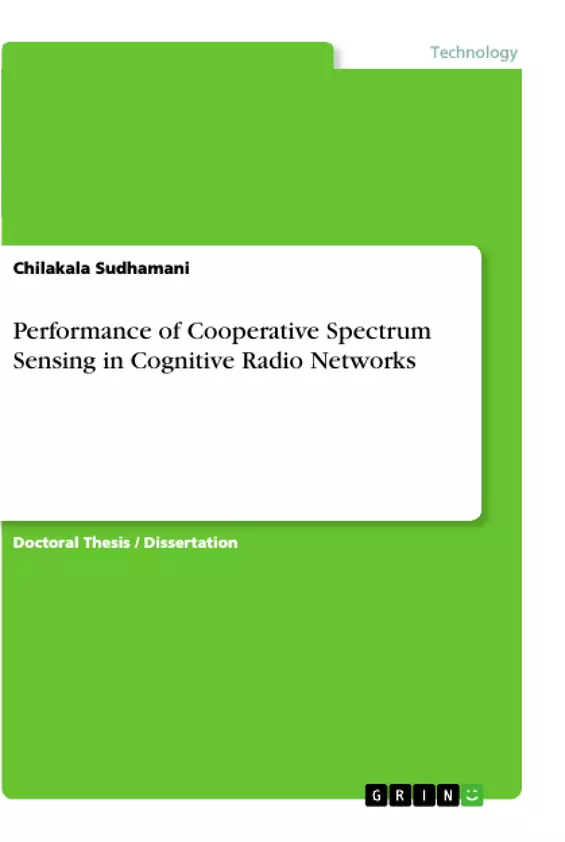Cooperative spectrum sensing technique is used to maximize the utilization of unused licensed spectrum. As the cooperation among the secondary users increases the detection performance increases, which increases the average channel throughput and energy efficiency but it depends on the number of cooperative secondary users, fusion rules, channel conditions and detection threshold. In this thesis average channel throughput, energy consumption and energy efficiency are estimated for variable number of secondary users and detection thresholds using hard fusion rules i.e. AND, OR and MAJORITY fusion rules. From the results it has been observed that the performance of AND fusion rule is better at low detection thresholds and for less number of secondary users. The performance of OR fusion rule is better at high detection thresholds and for large number of secondary users. The performance of MAJORITY fusion rule follows the performance of AND fusion rule at low detection thresholds and it follows the performance of OR fusion rule at high detection thresholds.
However as the number of cooperative secondary users increases the energy required for spectrum sensing and reporting sensing results to the fusion center increases, which increases the energy consumption and reduces the energy efficiency. Therefore energy efficiency can be improved by maximizing the average channel throughput or by minimizing the energy consumption. To minimize the energy consumption in cooperative spectrum sensing, optimization technique has been proposed in this thesis and it is used for further improvement of energy efficiency. With this optimization technique, optimal number of cooperative secondary users are derived by maximizing the energy efficiency using AND and OR fusion rules but not with MAJORITY fusion rule. Because it is very difficult to estimate the optimal number of cooperative secondary users using MAJORITY fusion rule, so optimization of final decision threshold was proposed in the existing methods to maximize the energy efficiency using MAJORITY fusion rule. Therefore AND and OR fusion rules are used in this work to optimize the number of cooperative secondary users.
Inhaltsverzeichnis (Table of Contents)
- Chapter 1: Introduction
- 1.1: Spectrum Sensing
- 1.2: Cognitive Radio
- 1.3: Cooperative Spectrum Sensing
- 1.4: Thesis Contributions
- 1.5: Thesis Organization
- Chapter 2: Literature Survey
- 2.1: Spectrum Sensing Techniques
- 2.1.1: Energy Detection
- 2.1.2: Matched Filtering
- 2.1.3: Cyclostationary Feature Detection
- 2.2: Cooperative Spectrum Sensing Techniques
- 2.2.1: Hard Combining
- 2.2.2: Soft Combining
- 2.2.3: Selection Combining
- 2.3: Performance Metrics
- Chapter 3: System Model and Problem Formulation
- 3.1: Cognitive Radio Network Model
- 3.2: Channel Model
- 3.3: Spectrum Sensing Model
- 3.4: Performance Metrics
- Chapter 4: Performance Analysis of Cooperative Spectrum Sensing Techniques
- 4.1: Performance Analysis of Energy Detection Based Cooperative Spectrum Sensing
- 4.2: Performance Analysis of Matched Filtering Based Cooperative Spectrum Sensing
- Chapter 5: Simulation Results and Discussion
- 5.1: Simulation Setup
- 5.2: Simulation Results and Discussion
- Chapter 6: Conclusion
Zielsetzung und Themenschwerpunkte (Objectives and Key Themes)
The thesis aims to investigate the performance of cooperative spectrum sensing in cognitive radio networks. The objective is to analyze the impact of different cooperative spectrum sensing techniques on the performance of cognitive radio networks in terms of detection probability, false alarm probability, and spectral efficiency.
- Cooperative spectrum sensing techniques
- Performance analysis of cognitive radio networks
- Detection probability, false alarm probability, and spectral efficiency
- Impact of different cooperative spectrum sensing techniques
- Spectrum utilization in cognitive radio networks
Zusammenfassung der Kapitel (Chapter Summaries)
- Chapter 1: Introduction provides an overview of spectrum sensing, cognitive radio, and cooperative spectrum sensing. It outlines the research problem, the contributions of the thesis, and the organization of the work.
- Chapter 2: Literature Survey reviews existing literature on spectrum sensing techniques, cooperative spectrum sensing techniques, and performance metrics used in cognitive radio networks.
- Chapter 3: System Model and Problem Formulation presents the system model and the problem formulation for the analysis of cooperative spectrum sensing in cognitive radio networks. It defines the channel model, spectrum sensing model, and performance metrics used in the thesis.
- Chapter 4: Performance Analysis of Cooperative Spectrum Sensing Techniques analyzes the performance of different cooperative spectrum sensing techniques, including energy detection and matched filtering.
- Chapter 5: Simulation Results and Discussion presents the simulation results of the performance analysis and discusses the impact of different parameters on the performance of cooperative spectrum sensing techniques.
Schlüsselwörter (Keywords)
The main keywords and focus topics of the thesis include cooperative spectrum sensing, cognitive radio networks, performance analysis, detection probability, false alarm probability, spectral efficiency, energy detection, matched filtering, and system modeling. This work explores the potential of cooperative spectrum sensing to improve the efficiency of spectrum utilization in cognitive radio networks.
- Quote paper
- Chilakala Sudhamani (Author), 2020, Performance of Cooperative Spectrum Sensing in Cognitive Radio Networks, Munich, GRIN Verlag, https://www.grin.com/document/901617



